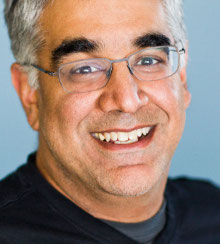Workday CEO: Cloud costs and future expansion plans


Some suggest cloud services could become more costly when providers eventually decide to return a profit, but Aneel Bhusri, co-chief executive of enterprise cloud apps company Workday, thinks the opposite more likely.
Software-as-a-service vendors are in fact banking on falling operational and infrastructure costs for their future profitability, according to Bhusri.
"All of us are counting on technology getting cheaper to get to profitability. We're not thinking that we're going to need to raise prices 50 percent to get to profitability," he said.
"All the [cloud] companies are now in high growth mode. As they get into slower growth mode where a lot of the customers are just renewing after their three-year contract is up and you don't apply any sales and marketing costs, those customers become a lot more profitable."
In fact, Bhusri believes even now current accounting methods are disguising the true profitability of software-as-a-service companies.
"The comparison between the cloud companies and the legacy companies is apples and oranges. So if you're SAP or Oracle, you sell the licence and you get to recognise that whole licence upfront. We'll sell a three-year subscription and we only get to recognise one year at a time," Bhusri said.
"If we were treated the same from an accounting perspective, we'd already be a profitable company. As you saw this last quarter, we're not trying to be cashflow-positive but we were cashflow-positive."
"The fairer measure for these companies in the long run is free cashflow. If you look at Salesforce, they're beginning to throw off a lot of free cashflow — they're generating cash. I'd argue with all the nuances in accounting: cash is king. That's how you really tell if a business is generating profits."
On-premise versus subscription accounting
An analysis of on-premise licences and cloud subscriptions would produce interesting results, according to Bhusri.
"If people really did the exercise to convert Salesforce as an example — say, Salesforce was under the same accounting rules as SAP — I bet they'd be two times their size and revenues and wildly profitable. It's just really the artefact of subscription accounting being different to licence accounting," he said.
Bhusri wants the company to sustain its focus on growth rather than profits for the foreseeable future.
"My goal is push it out as long as possible. Once we get to profitability, we'll be measured on that profitability. Right now people are more focused on the revenue growth and we're investing for that growth," he said.
Workday recently set out plans for UK and French payroll systems as part of a drive to secure more European subscriptions.
Workday's global expansion plans
Bhusri said there's still considerable scope for the firm to expand across the globe, with the point where there might be a dwindling supply of new customers still far in the future.
"Our average new customer has 10,000 to 20,000 employees. By our definition of our market opportunity there are over 10,000 organisations like that in North America and double that around the globe — so maybe 20,000," Bhusri said.
"We're at 450 so we're still tiny from a penetration perspective. When Oracle took over PeopleSoft, PeopleSoft had 8,000 customers, so there's a ton of market out in front of us."
So the number of prospects will not be an issue for Workday for the next five years, according to Bhusri, but even after that period there is a natural progression for the company to move into industry-specific applications.
"That would be a natural place for us to go. HR and finance are cross-industry, they work across all types of companies, but if you're going to go deeper into banking you need to think about banking and trading applications. If you're going to go deeper into retail, you need merchandise-management applications," Bhusri said.
"There are also great opportunities to sell analytics. Those big-data analytics we announced, those are an early offering. If you get the core HR and accounting system [into an organisation] and become that true system of record, there are so many adjacent opportunities around it."
Workday and professional services
For the moment Workday's expansion remains impressive but Bhusri suggests it's worth looking at the growth figures in detail.
"We grew 61 percent, but the more important number is actually the subscription number, which grew north of 80 percent. The two components of growth of our revenues are the subscription revenue, which is the software, and then the professional services revenue," Bhusri said.
"We're trying to slow down the growth of professional services and let the Accentures, Deloittes, IBMs, PricewaterhouseCoopers and Capgeminis, take on more of the work."
"We're really a software company. We did the professional services upfront because the service providers were in general slow to move to the cloud. They had great businesses on SAP and Oracle that they didn't want to jeopardise. But since the customers are going there, they've all jumped on the bandwagon."
Nevertheless, Bhusri said Workday would retain a small group of professional services people who could be deployed for project where special expertise is required.